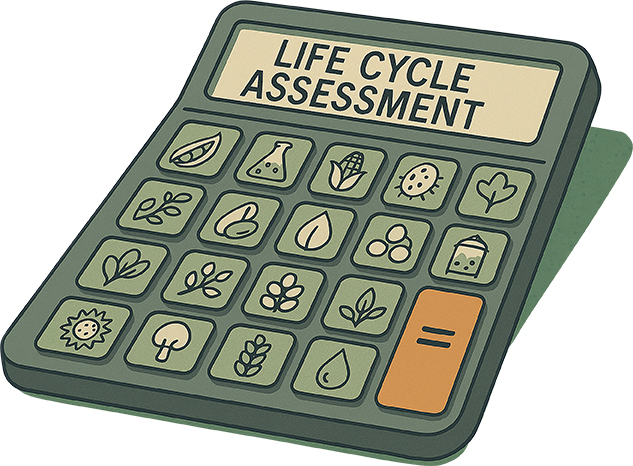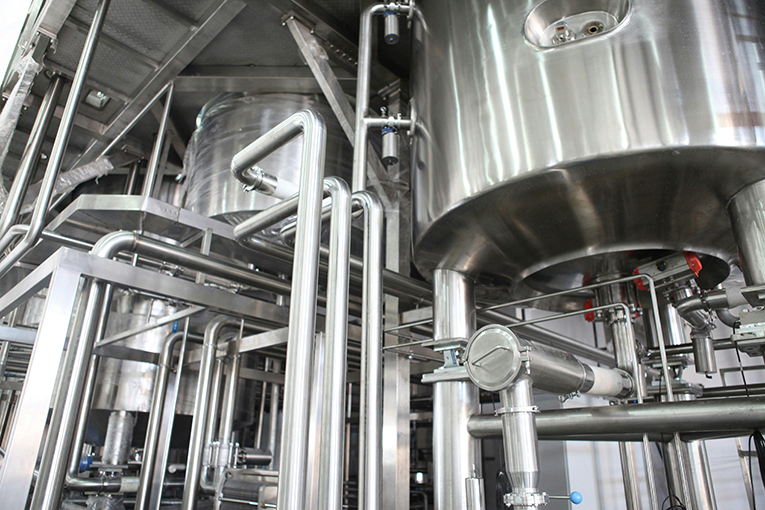

Deep Dive: Lifetime guarantee
Sustainability is a driving factor in the development of alternative proteins, but how is it possible to assess the life cycle or carbon footprint of a product that hasn’t yet existed for an entire life cycle? Louise Davis speaks with the pioneers working to answer this question
The issue of sustainability forms a critical tenet – and an obvious commercial selling point – of alternative proteins. It is natural that companies want to be able to declare how environmentally friendly their products are – particularly when compared with conventional proteins. But conducting product carbon footprint (PCF) and life cycle assessments (LCAs) for these products is ambitious and complex work.

It’s not only the fact that many alternative protein products are so new they’re not yet in mass production and haven’t been around long enough to complete a whole life cycle; what’s also muddying the waters is a lack of standardized and universally accepted methodologies for assessing these new foods, coupled with difficulty in accessing the data required for accurate assessment.
Despite the many challenges, conducting assessments is both possible and, for many players, very desirable. As well as the merits in terms of marketing claims, positive results from an LCA can influence business strategy, investor confidence, and regulatory compliance – not to mention highlight areas where operational improvements can be made.
Future forecast
Neatly summarizing both the challenges and benefits of LCA work for this industry, Pelle Sinke, a researcher and consultant at Dutch consultancy, CE Delft, says, “Prospective LCAs of future, large-scale production provide the most valuable information, and can inform us of the sustainability potential and hurdles of alternative proteins. At the same time, these prospective models rely on theoretical models, as large-scale production does not yet exist for most alt proteins.” Sinke advises that technology experts and LCA practitioners should work closely together to create the right LCA models. “Similarly, some aspects of the supply chains still need to develop and mature,” he points out.
Given the evolving nature of the industry, how do organizations such as CE Delft ensure the accuracy and reliability of LCAs for alternative proteins? “Transparency in reporting and adhering to quality LCA guidelines is key,” Sinke answers. “This ensures comparability of studies and enables us to correctly interpret results (and remaining uncertainties). Specific LCA recommendations for cultivated meat are being developed by a group of experts from the field, and this could also be done for other alt proteins.”

Sinke reports that, despite this type of research being at a relatively early stage, LCA results are already translating into positive contributors in areas such as policy and investment. Citing one example, he notes, “In the Netherlands, LCA results formed an important component of the successful €60 million (US$68 million) government subsidy application for development support of a cellular agriculture ecosystem under the Cellulaire Agricultuur Nederland umbrella.”
When asked how LCAs for alternative proteins compare to those used for conventional animal agriculture, Sinke’s thoughtful response considers all angles. “Uncertainties are more substantial in LCAs for alt proteins, and therefore these studies often include various scenarios,” he explains. “These need to be communicated and interpreted correctly. Also, the comparison should be fair. On one hand, conventional animal agriculture is a mature technology with economies of scale – comparing that to pilot-scale production of alt proteins with immature technology and supply chains is not fair. On the other hand, one should be cautious in communicating overly optimistic scenarios as the most probable results for alt proteins,” Sinke warns.
Chicken and egg situation
One optimistic real-world scenario that CE Delft encountered recently came from its work conducting an LCA with Israeli cultivated chicken company, SuperMeat. Osnat Shostak, SuperMeat’s VP Business Development, confirms that the LCA’s findings were highly encouraging. “Our cultivated chicken demonstrated up to a 47% lower carbon footprint compared to the most ambitious benchmarks for conventional chicken, with even the baseline scenario, which assumes standard US grid electricity and a non-optimized supply chain, showing a 27% reduction.”

Detailing this achievement, Shostak adds, “Key contributors to the performance are our continuous production process and high-efficiency feed-to-meat conversion. The LCA confirmed that our platform substantially reduces land use (by 90%), acidification, and particulate matter formation – showing that cultivated meat, when produced efficiently, can make a real difference in reducing agriculture’s environmental footprint even when compared to chicken, the most efficient conventional animal protein. To date, we believe SuperMeat is the only company to publicly share a full LCA for a 100% cultivated meat product – not a hybrid product – offering a new level of transparency in the field.”
These are impressive results, but Shostak is happy to admit that proving them was not easy. “The biggest challenge was the lack of available data from upstream suppliers, particularly regarding the environmental footprint of ingredients used in the food-grade culture medium,” she recalls. “Although we can more accurately assess our performance at scale based on data from our own pilot facility, many of our suppliers are still adapting their manufacturing processes to meet food-grade standards and have yet to scale, and our access to this data is limited. As these upstream inputs, especially culture media, account for a large amount of the product’s environmental footprint, this lack of supplier-specific data required CE Delft to rely on modeling and conservative assumptions. As the supply chain matures, we plan to refine these parameters and integrate them more deeply into our supplier selection process.”
Shostak also feels that there are areas where current LCA methodologies fall short in reflecting the full sustainability impact of alternative proteins. “Conventional LCA methodologies tend to underrepresent dynamic innovation pathways and the potential of emerging technologies to achieve rapid sustainability gains,” she comments. “In cultivated meat, where improvements in cell density, feed conversion, and energy use can evolve quickly, the methodologies don’t fully capture the pace and scale of expected advancements. Additionally, current LCAs rarely factor in system-wide shifts, such as reducing the need for antibiotics, or the broader public health and biodiversity benefits from transitioning away from animal agriculture, which limits the scope of the analysis.”
Despite acknowledging these shortcomings in methodology, SuperMeat is certainly finding much value in the results of its own LCA with regard to planning its large-scale production. “The LCA is helping us prioritize suppliers with high water-use efficiency, sustainable sourcing practices, and strong environmental compliance, particularly for culture media components, which account for the majority of our footprint,” Shostak explains.

And, she adds, “On the production side, the findings reinforced the importance of optimizing our continuous process for scale and investing in renewable energy integration and spent media usage. Strategically, the data is guiding how we position our technology as a high-efficiency, low-footprint meat production platform – a message that resonates both with partners and future regulators.”
Peer power
Another company that has publicly shared a first-of-its-kind study is French food-tech firm Verley (which was previously known as Bon Vivant). In November 2024, Verley released the first European peer-reviewed LCA on precision fermentation dairy proteins.
The study was conducted under ISO standards and peer-reviewed by independent experts from both Europe and the USA. The panel included Dr Greg Thoma from Colorado State University, and Dr Sumesh Sukumara from DTU Biosustain, with Dr Michael Hauschild from the Technical University of Denmark serving as the lead reviewer. “We decided to go for peer review for three reasons,” begins Hélène Briand, Co-Founder & CTO. “Firstly, it is part of the requirement for ISO 14044. Next, it shows our willingness to be transparent on our mode of production and our seriousness of applying the right methodologies. And, finally, there are too many companies claiming LCA values without a methodology validation, leading to inaccurate, potentially harmful assumptions.”
Briand notes that it was important to include peers from both sides of the Atlantic because “we are targeting both markets and we wanted to ensure our methodology is fitting both, thereby demonstrating universality”.
The findings of the LCA were extremely positive. It revealed that producing dairy proteins via precision fermentation dramatically reduces environmental impacts, including a 72% cut in greenhouse gas emissions, an 81% decrease in water usage, and a remarkable 99% reduction in arable land use compared to conventional dairy protein production. And Briand reports that Verley is deriving much value from these results. “We have been a pioneer in performing the LCA on our process at an early stage, and refined it with a peer review and scale data. This helped us identify where to focus our energy in terms of R&D to match the technology promises with upscale realities.” She highlights one prime example here. “Thanks to this methodology of LCA, we identified that the fermentation process is as important as the downstream process, and that valorization of biomass in feed must be in our roadmap.”

Verley’s role as a pioneer means it can comment with some authority on the shortcomings of current LCA methodologies in reflecting the full sustainability impact of alternative proteins. Briand primarily feels that more universality in the selection of comparison models is required. “We compared our protein with finished products,” she says. “Therefore, we add into our LCA the weight of additional components to be nutritionally equal to milk. But others are comparing their products with milk ingredients.
“Allocation is also an issue. We are missing clear guidelines for allocations, which can lead to hidden impacts. Also, despite efforts on having ISO 14044 standards, it is missing universal rules established for the Product Environmental Footprint category for Precision Fermentation (PEF CR). This exists for the dairy industry but not yet for precision fermentation, and that often leads to incomparable or inaccurate and unproven assumptions from multiple players, making studies non-comparable.”
Within such a murky, complicated landscape, Briand heralds the positive influence of the peer-review process. “There is no clarity on sustainability regulations yet, but the peer review is starting to be recognized. I would call for this peer review to be added as a mandatory step for all types of LCA before disclosing, because it guarantees the methodology is well applied.”
Deep impact
Like Briand, Reagan Cerci, Senior Research Analyst at Boundless Impact Research & Analytics, also adheres to standards such as ISO 14040/44, as well as databases such as Ecoinvent, when conducting LCAs for alternative proteins companies. Also like Briand, she believes that transparency is key to success – along with the need to acknowledge the shifting sands facing all researchers in this sector.
“Accuracy and reliability come down to data quality, transparency, and sensitivity analysis,” Cerci comments. “Given how rapidly the alternative protein landscape is evolving, we prioritize primary data collection directly from producers wherever possible – whether it’s energy use, inputs, or yields. Where direct data isn’t available, we document assumptions meticulously and conduct uncertainty analyses to highlight variability. Importantly, we treat LCAs as living documents that must evolve as the technology and supply chains mature.”
Cerci works across all facets of the alternative proteins industry, so is ideally placed to comment on specific challenges each part faces when conducting LCAs. For precision fermentation, she says that the work is often IP-sensitive, “so firms are reluctant to share upstream process data such as titers, yields, or energy demands. Fermentation inputs (e.g. sugars, growth media) can also vary widely.”
For cultivated meat, she observes, “Much of the tech is still pre-commercial for the most part, so we’re often modeling lab-scale processes and projecting to industrial scale, which introduces huge uncertainty. Cell growth rates, media recycling, and bioreactor energy efficiency are all highly variable and not standardized. Broadly across the industry, it is difficult to get accurate data for cultivation media due to IP protections.”
And with regard to plant-based proteins, Cerci notes, “Agricultural inputs are more accessible, but there’s often a lack of granularity in how crops are grown (e.g. rainfed versus irrigated), processed, and transported, especially across global supply chains.”

When asked how assumptions about energy sources (e.g. renewable versus fossil-based) impact LCA results for alternative proteins, Cerci emphasizes that they can make or break the carbon footprint. “Energy is often the largest contributor to impacts, especially in alternative proteins. A system powered by coal versus one running on solar or hydro can differ by an order of magnitude in GHG emissions.” Hence, Cerci and the team at Boundless often run LCAs under multiple energy scenarios – baseline grid mix, 100% renewable, and transitional mixes – to show the range and help companies make region-specific decisions. “It’s also critical for identifying the marginal benefit of decarbonizing energy inputs,” she adds.
Cerci offers some valuable insight when discussing how LCAs for alternative proteins compare to those used for conventional animal agriculture. “Animal agriculture LCAs benefit from decades of data, especially for ruminants, but they often exclude key externalities such as land-use change or biodiversity loss,” she details. “They are also often inconsistent in allocation methodology as most animal agriculture is conducted for a variety of co-products, which then need to be individually assigned a portion of the carbon footprint. Using databases such as Ecoinvent can help standardize the conventional approach, but they limit the researchers’ ability to compare specific parameters.”
Cerci also points out that there is a gap in data for conventional fish products. “Fisheries can have impacts on fish population abundance, physical structures of environments, megafauna and top predator populations, and nutrient flows. Accidental fishing (commonly referred to as ‘ghost fishing’), resulting from discarded or broken gear left in marine ecosystems, can also have detrimental impacts on marine health. However, this is often difficult or impossible to accurately track due to a lack of reporting or knowledge.”
Putting this into context, she says, “Although most LCAs do not attempt to quantify these ecosystem impacts, it can be inferred that, as alternative proteins are producing fish meat without the necessity of fishing, they are avoiding these biodiversity and ecosystem impacts.”
In general, Cerci says that LCAs for alternative proteins are typically more detailed in modeling supply chains and energy use but often rely on early-stage data. She notes that researchers here face gaps in areas such as infrastructure impacts (e.g. stainless steel fermenters) or waste management. “Closing the gaps will require open-data sharing and more real-world, operational data from commercial producers,” she states.
Czech point
One person more than happy to share his own data is Roman Kriz, CEO of Bene Meat Technologies – a Czech company working in cultivated meat. Hot on the heels of the October 2024 announcement that it has successfully produced its first cultivated beef burger, the following month, the company announced the results of an LCA into the environmental impacts of cultivated meat production on an industrial scale. “Because our efforts are fundamentally geared toward scalable, industrial production, we are in a unique position. Bene Meat Technologies is among the first companies globally able to examine and quantify the real environmental impacts of cultivated meat under realistic, production-scale conditions,” Kriz reports.
The study was conducted in collaboration with the Czech Technical University in Prague (ČVUT), led by Dr Miroslav Žilka and independently peer-reviewed by Professor Jon McKechnie from the University of Nottingham. Summarizing the results, Kriz says, “The peer-reviewed study found that our pet food generates at least 84% fewer emissions than beef – depending on how the latter is produced, the difference could be as much as 95%. It also uses between 80-97% less land than beef, with the potential to reduce this even further. Although these numbers were specifically calculated for pet food, we believe beef burgers for humans will perform similarly on the sustainability scale.”

Perhaps surprisingly, on the operational side, Kriz reports that having these figures doesn’t make a huge difference to Bene Meat Technologies’ commercialization plans. “Although LCA data for cultivated meat is one of the factors investment partners have to consider due to their ESG/SDG goals, we are not dependent on external funding. Nor does the LCA data influence our business decisions: the benefits of cultivated meat for consumers (regardless of whether they are pets or humans) is the top priority for us. The environmental impact is a positive (and very welcome) extra.”
So, if the LCA data wasn’t critical for investment and won’t determine the direction of progress on the production side, why did Kriz actually decide to conduct the study in the first place? “Well, I think it is important to distinguish between a company’s motivations and goals and those of individual people. Our company’s main goal is to develop a product that makes sense from the point of view of the second law of thermodynamics,” Kriz states. “But we wanted to confirm that our expectations regarding the positive benefits that cultivated meat can bring were true. We wanted proof of the positive environmental impact of cultivated meat for those people who regard this as the number one priority (including people in our team here at Bene Meat Technologies). And we wanted proof based on real data for those people who are not currently big fans of cultivated meat – as they usually argue that the environmental benefits are merely projections and expectations.”
Another group of people who Kriz also considers in LCA discussions is the end consumers of cultivated meat products – a group whose motivations for buying such products are also difficult to assess. “It’s hard to evaluate whether sustainability claims based on LCAs are a strong selling point for consumers because other factors – notably price, taste, and nutrition – play a key role, too. Nevertheless, even if the LCA data is not the consumer’s main concern, it is certainly an additional benefit. It is beneficial for consumers and producers alike to have the (proven) option to leave nature in the same condition as it was before us.”
If you have any questions or would like to get in touch with us, please email info@futureofproteinproduction.com







